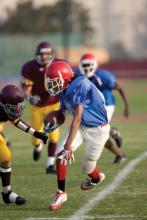Many ECGs are misinterpreted, which could be detrimental to young athletes if ECGs became a part of routine sports preparticipation screening, Dr. Allison C. Hill and her colleagues suggested, in light of their findings in an online questionnaire–based study published July 14 in the Journal of Pediatrics.
Because of the rise of sudden cardiac deaths (SCDs), some European countries now require preparticipation screening ECGs. Currently, in the United States, the American Heart Association recommends a thorough checkup every 2 years. However, there has been an urge to include ECGs in preparticipation examinations even though the accuracy of interpreting them has been questioned (J. Pediatr. 2011 [doi: 10.1016/j.jpeds.2011.05.014]).
"Although other countries have enacted laws mandating ECG screening for their athletes," Dr. Hill of Stanford (Calif.) University, wrote, "the difficulty of interpreting ECG results, combined with the very large population of young athletes in the United States (more than 10.7 million), may make such laws impractical."
A total of 53 of 212 pediatric cardiologists from the Western Society of Pediatric Cardiology voluntarily responded to an online survey, interpreting 18 ECGs from the Lucile Packard Children’s Hospital at Stanford. Eight of those ECGs were from patients with normal hearts, and 10 were from patients with conditions that might cause SCD. Those conditions included long QT syndrome (one), hypertrophic cardiomyopathy (four), Wolff-Parkinson-White syndrome (two), pulmonary arterial hypertension (one) and myocarditis (two).
The pediatric cardiologists, most of whom had been practicing for 5-15 years and almost half of whom read more than 100 ECGs/month, were asked to determine whether the ECG was normal or abnormal and to interpret it. Respondents also were asked what heart conditions they thought each patient might have, what additional tests the patient should receive, and whether or not the patient should participate in athletic events. The ages and sexes of the patients were given to the respondents; no other clinical information was provided.
To compare with the respondents’ answers, two pediatric electrophysiologists also took the online survey and had 100% concordance for all diagnoses.
The respondents were given one point for each correct diagnosis and one point for each correct permission for sports participation, for a total of 36 points. Only 69% of the ECG interpretations were correct, with a mean score of 12.4 of a possible 18. The range of correct interpretations was 34% for pulmonary arterial hypertension to 98% for long QT syndrome. In all, 71% of respondents correctly identified normal ECGs. The mean percentage for correct sports participation was 78% (14 of 18).
According to the study, the respondents had a sensitivity of 68% and a specificity of 70% for recognizing any abnormality in the ECGs. The false-positive and false-negative rates were 30% and 32%, respectively.
As for the follow-up tests, both the respondents and experts ordered 508 additional tests for the 18 patients. However, the respondents ordered 380 more unnecessary tests and missed 340 tests that the experts would recommend.
According to the study, the most common cause of SCD in the United States is hypertrophic cardiomyopathy. Only 59% of all respondents were able to correctly identify this entity. Researchers note that although some respondents were not able to identify the underlying disease, they were still able to identify that there was some sort of abnormality.
"One problem with interpreting athletes’ ECGs is that, as athletes’ hearts grow stronger, they may get somewhat larger and beat more slowly," Dr. Hill said in the statement. "Although these changes are normal for a well-trained athlete, they can look similar on ECG scans to defects that predispose people to sudden cardiac death."
The findings suggest that the difficulty in interpreting ECGs can be costly, both monetary and physically for athletes. A misinterpreted ECG may lead to an undiagnosed issue, which can be dangerous for athletes who were given permission to continue participating in athletic activity. The study also identifies a need for more training in pediatric cardiology, according to the researchers.
Researcher Dr. Anne M. Dubin of the university received fellowship support from Medtronic. The other researchers had no relevant financial disclosures.


